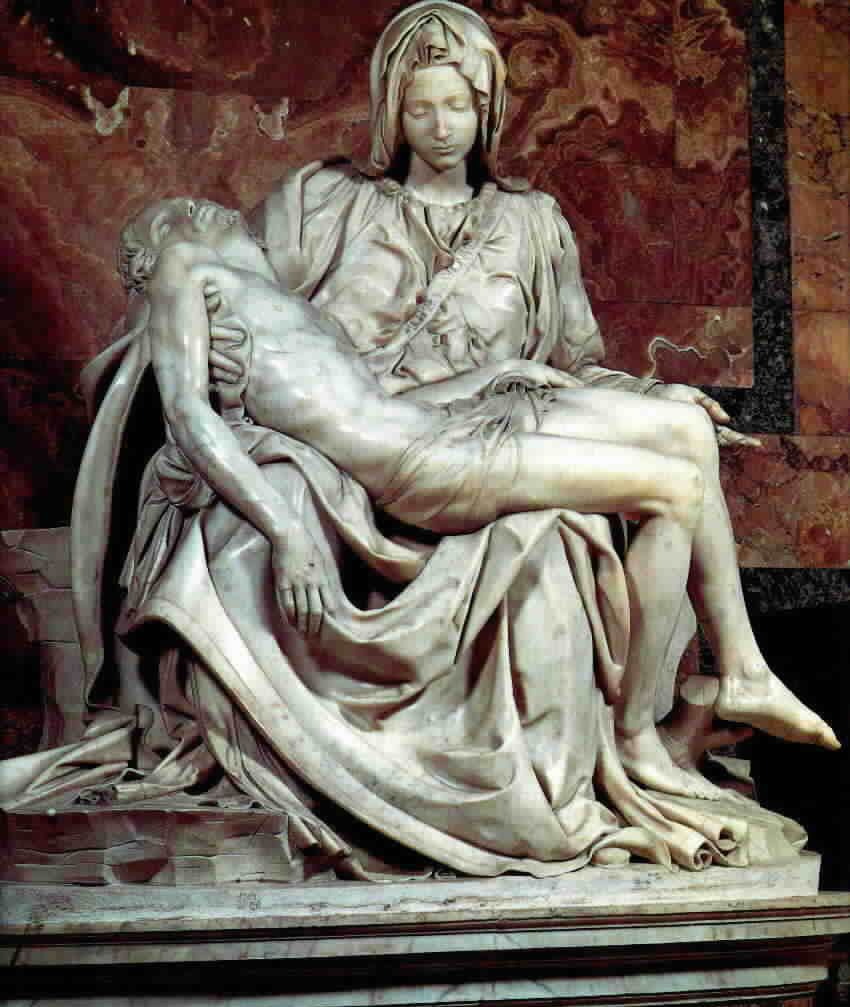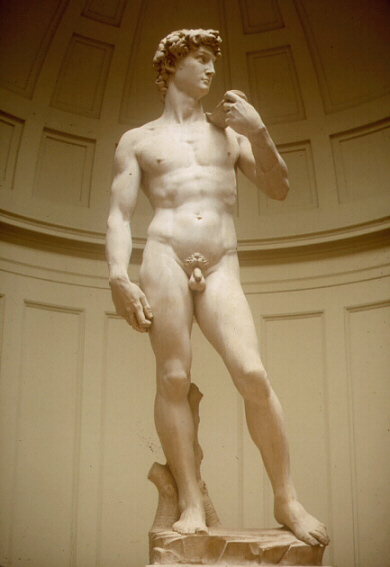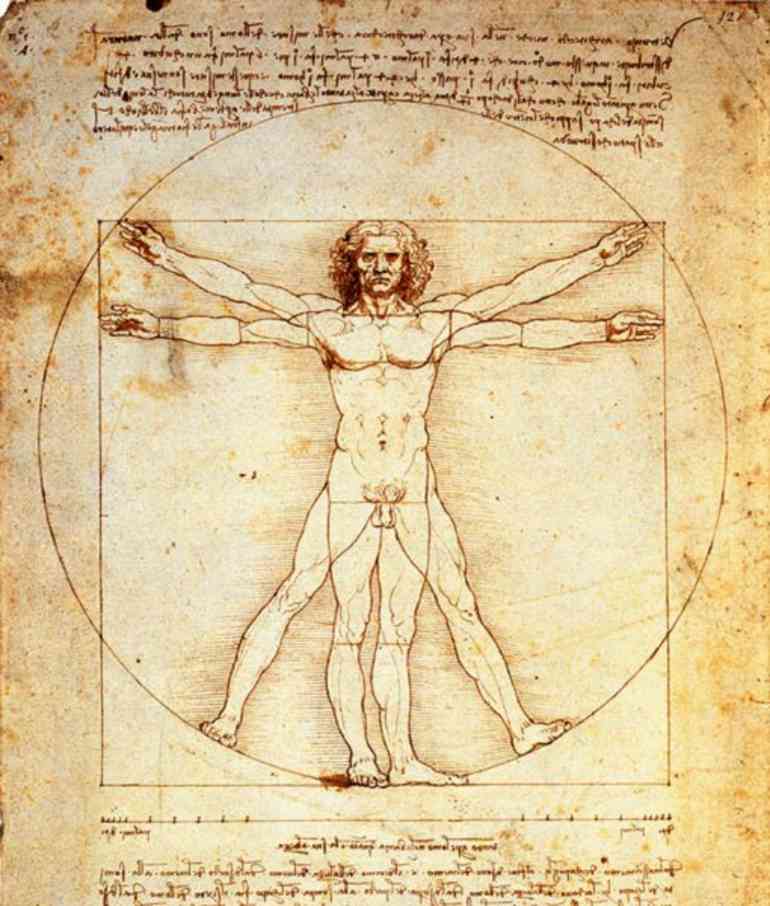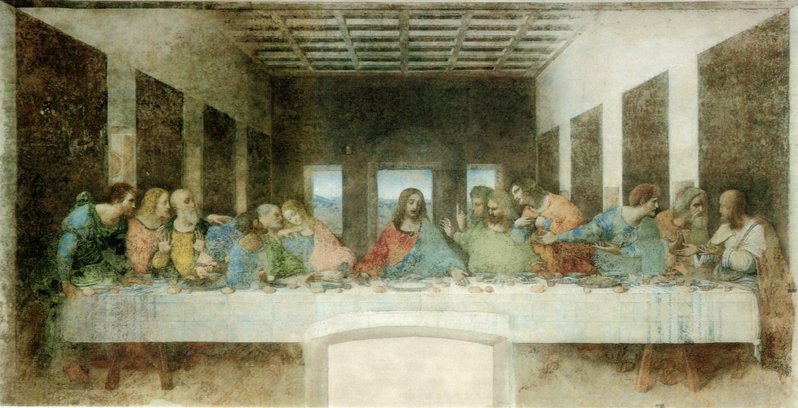
Reserved Area
Artists - ArtWorks
Leonardo Da Vinci, Michelangelo Buonarroti, Raffaello Sanzio, A Comparison
 Italy
ItalyReinassance Art and Architecture in Italy
Leonardo born at Vinci in 1452, Michelangelo born at Caprese in 1475, Raffaello born at Urbino in 1483.
At 15 Leonardo is sent to Florence to work as apprentice to Andrea Verrocchio. In 1482 Leonardo moves to Milan to work in the service of the city's duke, Ludovico Sforza. He gains the title of "Painter and Engineer of the duke. In 1499 with the duke Ludovico Sforza's fall from power, Da Vinci leaves Milan and spends a short time in Venice. 1502 Leonardo begins work as senior military architect and general engineer for Cesare Borgia, son of Pope Alexander VI. 1516 The king of France invites Leonardo to come work for him. 1519 May 2, Leonardo dies in France.
In 1492 Michelangelo goes in Venice then Bologna after the expulsion of the Medici family from Florence. After a trip to Rome , he went back to Florence, and decided to spend some time studying with Perugino in Perugia. In 1505 Michelangelo is called by Julius II. In 1506 he goes back to Florence. In 1508 Michelangelo is called in Rome to depict the Sistine Chapel Ceiling. The new government in Florence called and asked him to prepare plans for defence against the assault. 1534 Leaves Florence forever. 1564 he dies on February in Rome.
Raffaello is apprenticed in Urbino at his fathers workshop, until 1504 he studies the work of Perugino, Piero della Francesca, Signorelli. Between 1504 and 1508 Raffaello lives in Florence. The influence of the two masters Leonardo and Raffaello determined his artistic evolution. In 1508 Raffaello is introduced by Donato Bramante at the Court of Pope Julius II. In these years Raffaello worked on the rooms of the Vatican. He dies in 1520.
Italian Art from the 1490 to the Sack of Rome(1527)has been considered the Imperial Style. Major artists trained and practiced in Rome, Florence and Northern Italy, but also in Spain, Germany and France, spreading Renaissance Humanism and the Italian Renaissance style throughout Europe.
The Sixteenth Century was an age of social, intellectual and religious ferment that transformed European culture. The Humanism of the 1400's slowly opened to a spirit of discovery that led Europeans to explore new ideas, given also by the use of the printing press that permitted to broaden the horizon of education.
At 15 Leonardo is sent to Florence to work as apprentice to Andrea Verrocchio.
Michelangelo is apprentinced to Ghirlandaio in whose workshop he learned the fresco techniques.
Soon he joined the court of Lorenzo il Magnifico, where he came to contact with the Neoplatonic Philosopy.
Raffaello is apprenticed in Urbino at his fathers workshop, until 1504, then he starts to get interested in the work of Perugino, Piero della Francesca and Signorelli.
School of Athens is one of the most representative works by Raffaello Sanzio, whom absorbs the lessons of Michelangelo and Leonardo and merges it on a wonderful fresco at Stanza della Signatura in the Vatican's Apostolic Palace. It seems to be recognizable the identity of some of the contemporaries of Raffaello in the figures portrayed, such as Leonardo, Bramante, Michelangelo and Raffaello Himself as Plato, Heraclitus, Euclid and Apelles. Raffaello absorbed Michelangelo’s glorification of the nude figure, in the Sistine Chapel Ceiling. As Michelangelo placed great importance on the human figure which he managed to capture in of extraordinarily vital poses, Raffaello captured the essence in such a way that moral greatness was represented through physical power.
The formidable statuesque presence of the human figures painted by Michelangelo is attributable to his love for sculpture, but Raffaello added poetry and kindness to his characters, helped also by the Aerial perspective assimilated from Leonardo, that gave at the figures ethereal energy.
As said Raffaello’ work is influenced by two of the most important artist of the Centuries, but instead of coping them he elaborates their works and merged it into a delicate beauty, candid and poignant atmosphere, fusing the impetuous touch of Michelangelo and the scientific study of Leonardo in tha affecting world of Raffaello.
Italy in this period is very influent on the work of other artists, in Italy and outside Italy. Formal innovations and tonal improvements renewed the Century tradition influencing also other Countries.
His career falls naturally into three phases and three styles, first described by Giorgio Vasari: his early years in Umbria, then a period of about four years (from 1504-1508) absorbing the artistic traditions of Firenze, followed by his last hectic and triumphant twelve years in Roma, working for two Popes and their close associates.
It has been decided to compare the work of Raffaello Sanzio with two of the major artist of the Sixteenth century because it seemed relevant to underline Raffaello influences of Michelangelo e Leonardo, the most representative artists of the history.
M. Stokstad- Art History, Pearson/Prentice Hall 2005
Ernest Gombrich- History of Art, Phaidon Bertelli- Storia dell’arte Italiana, Electa Mondadori
Related Material:
Image available

File name: 27_01 Agnolo Doni.jpg
Description of the material:
Agnolo Doni
Contextualisation Of the source:
Raffaello

File name: 27_01 Pietà.jpg
Description of the material:
Pietà
Contextualisation Of the source:
Michelangelo

File name: 27_02 David.jpg
Description of the material:
David
Contextualisation Of the source:
Michelangelo

File name: 27_02 Madonna del cardellino.jpg
Description of the material:
Madonna del cardellino
Contextualisation Of the source:
Raffaello

File name: 27_03 Uomo vitruviano.jpg
Description of the material:
L'uomo Vitruviano
Contextualisation Of the source:
Leonardo Da Vinci

File name: 27_04 Ultima cena.jpg
Description of the material:
L'ultima cena
Contextualisation Of the source:
Leonardo Da Vinci
Comments about this Artist/ArtWork
Date: 2009.09.13
Posted by ulrich krumsieg, germany
Message: Very informative,
sometimes you need more time for reading....
Date: 2009.05.26
Posted by Teodora Zeia, National School of Arts "Dobri Hristov"-Varna, Bulgaria
Message: Leonardo was the first artist, whose creative work was a reflection of all the distinguishing features of the Renaissance in its higher stage together- a new art, an attitude towards reality that was different from the religious outlook. The individualism developed as comprehensive activity and at the same time the subjectivism was implemented in the process of creation, which led to the independence of art. It was no longer a mere illustration of religious books, it turned over towards nature, painting became a window to the world. There were various preconditions for all these changes- social, philosophical, ideological and scientific. In this train of thought I believe it is worth noting that all the three geniuses of the Italian Renaissance-Leonardo, Michelangelo and Raffaello, had a common characteristic- neither one of them was a painter solely. Leonardo brought science and art together, he considered them two conceptions that overlap to a great extent. His scientific searches contributed to his achievements as painter: for example, while dealing with the problems of optics, he reached the idea of “sfumato” (“smoky”)- the technique “which overlays translucent layers of colour to create perceptions of depth, volume and form”. He built his compositions on a geometrical principle, regarding the perspective. Just like Leonardo Michelangelo did not consider himself a painter only. First and foremost he was a sculptor, an architect, even poet. Besides being a painter, Raffaello was an architect. He was also appointed as a chief preservator of the ancient ruins of Rome.
Date: 2009.05.22
Posted by Nadia Petrova, NSA, Rousse, BG
Message: This comparative analysis of the work of the three masters gives a very interesting outlook on how their art developed during one and the same time period. Together with this material for Bulgarian students it would be really useful to also go through the biographies of the three authors, which are available in BG at: http://my.opera.com/Ars_longa/blog/leonardo-da-vinci1; http://bg.wikipedia.org/wiki/Рафаело_Санцио; http://www.sivosten.com/content.php?review.48.
Date: 2009.04.28
Posted by D'AMICO FILIPPO
Message: The technique of Rafael is really prodigious, the depth of expression was innovative; it was a precocious alievo from the Perugino, he immediately reveals genial to the eyes of the more experts.
Date: 2009.04.24
Posted by TOMMASO CHIAPPA
Message: in the first paragraph dedicated to Leonardo's life, I would have dedicated more importance to the apprentice not only reguarding Leonardo, but also concerning all the renaissence artists, and would have focused on how this practice is to consider as a base for the developing of the art of all the major old masters.
Date: 2009.04.22
Posted by Sandra Mandaglio
Message: I found this project to be quite interesting and the possibility that it offers to relate and communicate with other countries with common issues for italian art, the 500th century was of great succes. Especially for the use of color and therefore I tried to apply the theory of color of Itten to seven paintings of seven different great artists of Mannerism for every theory of contrast.
Date: 2009.04.22
Posted by Florinda Mungiello
Message: The work that I have put together for image art was quite interesting especially for the use in morphing, which has allowed me to highlight and bind certain aspects that represent the 15th century painting.
Date: 2009.04.21
Posted by Lidia Aceto
Message: For a course of our we worked on the general sence of Manierism, and in particular we focused on the caracteristic use of colour, the Movement, the "figura serpentinata". It was quite interesting as we discovered that the outstanding Mannerist trademarks - distorted space and human figures, a desire to shock, obscurity and a withdrawal from nature in favor of recording an inner and often highly intellectualized vision - are frequent in 20th century art. The artists were educated in the finer points of artand their work was influenced by imagination and based on fantasy, and it was largely aimed at the enjoyment of an audience.
We intended to underline this aspects with a contemporary tool and make it evident as a educational product.
Michelangelo - Copyright 2008 - This project has been funded with support from the European Commission